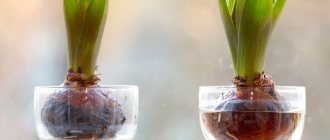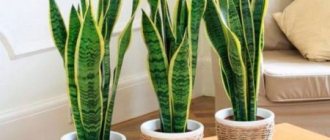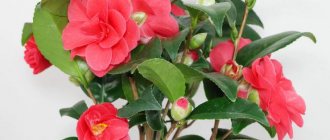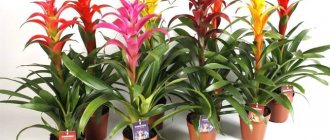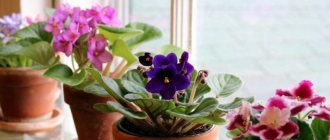The amazing world of plants that fills the planet brings a lot of joy to flora fans. However, some people only like hypoallergenic flowers with a subtle aroma. In the spring, when the garden is filled with colorful colors, real torture begins for them. It’s sad, but the torment ends in late autumn, along with the fallen leaves. What will help you stop seasonal suffering and enjoy the beauty of nature 100%? Maybe declare war on flowers that cause allergies? There is a more humane way. First of all, let's find out why plants cause allergies? And then we will get acquainted with popular hypoallergenic flowers that can be grown in the garden or indoors.
Aloe
An unpretentious house plant that brings great benefits. The list of medicinal properties of aloe is large: from healing abrasions and burns to strengthening the immune system. Experts recommend placing aloe in the room of people suffering from asthma.
The plant is absolutely safe for allergy sufferers and small children. The edges of the fleshy leaves are framed by a number of soft spines that are not capable of causing serious damage, and the juice of the leaves is harmless. What is especially important if a child breaks off a plant while playing.
Aloe does not like direct sunlight, so choose a bright place without bright lighting.
Dust collecting on the leaves can pose a danger to allergy sufferers. Therefore, they need to be wiped regularly.
Optimal solutions
Of course, many are interested in which plants can be called safe. “The most non-allergenic flowers are usually bushy or bushy, the same rose, climbing rose is also safe. Artificially bred sunflowers can be an excellent solution - they are odorless, do not have an oily base and do not contain seeds. Orchids, phlox, and petunia can also be called safe - they are often given as gifts in the spring, including on holidays, even in pots,” says Anna Shulyaeva.
In addition, experts recommend paying attention to flowers with a dull color, preferably light ones. All rules are the same for both bouquets and gifted potted plants.
Croton
The spectacular croton with carved colored leaves is also safe if you have allergies. Its glossy leaves do not attract dust, and the low need for watering prevents mold from developing in the soil.
The plant requires care and the slightest disturbance affects its appearance. Croton grows in the form of a tree or bush.
In a children's room it is better to keep it on the windowsill, and in large rooms it grows well in a floor planter.
Symptoms of the problem
An allergy to donated flowers usually does not differ in any special set of signs and symptoms. The person will also feel:
- itching in the nose;
- redness of the eyes;
- increased lacrimation;
- nasal congestion;
- sneezing and other traditional plant allergy symptoms.
Are you allergic to cold? Why is sneezing in winter treated by an ENT specialist? Read more
Naturally, you will have to part with the allergen and undergo therapy with antihistamines. Therefore, it is better to prevent unwanted reactions. But you shouldn’t deny yourself the pleasure of receiving bouquets - the main thing is that they are collected correctly and are as natural as possible and not too intense in smell.
Peperomia
Peperomia will be an assistant in maintaining and restoring health. It has the properties of purifying the air from microorganisms that cause diseases and allergens.
The plant is compact and very decorative. The advantages are low maintenance requirements. Peperomia can grow and even bloom in the shade, and it is watered when the soil becomes completely dry.
Be careful, bouquet (or not)
Allergies are a chronic disease caused by an unwanted reaction of the immune system to everyday things.
For example, on spores or pollen of flowering plants. Normally, a person should not notice them at all. Symptoms:
- runny nose with nasal congestion, complete loss of smell, hoarse voice, sneezing;
- conjunctivitis with redness of the eyes, watery eyes, itching;
- dermatitis (usually on the face and hands), which is accompanied by dry skin, the appearance of spots, and a strong desire to scratch;
- hacking cough, which intensifies during stress and is accompanied by a sore throat;
- fatigue, drowsiness and irritability due to physical discomfort.
This allergic reaction is called hay fever. This is a seasonal phenomenon, depending on flowering and weather: the wind carries pollen over many kilometers, so symptoms appear even in those people who live very far from the place where the allergen grows. Allergies cannot be cured, only symptoms can be relieved.
Often cause allergies:
- strong-smelling flowers (lilies);
- asteraceae - daisies, daisies, sunflowers;
- flowering cereals, they are used to decorate designer bouquets;
- fern spores.
After contact with industrially grown flowers, sensitive people may have contact reactions such as urticaria or local itching. They pass quickly and depend on what the plants were treated with before cutting: unscrupulous producers sometimes spray the flowers with a mixture of pesticides to prolong the life of the beautiful ones, but - alas! fragile buds.
Therefore, you need to buy bouquets in stores that value their reputation and cooperate only with certified greenhouses that do not resort to such tricks. For example, the BouquetsMigom delivery service carefully selects suppliers and guarantees the high quality and safety of the flowers it sells.
Begonia
Begonia loves a bright place and abundant watering. Its large, fleshy greens act as a filter that cleans the air of dust and bacteria. And the essential oils released by the plant have a beneficial effect on the respiratory tract.
Unlike other pubescent plants, begonia is not dangerous for allergies and for children. Its hairs do not fall off and have a soft structure, without hooks at the end.
Additional threat sources
While pollen is the plant-related allergen that people typically fear most, there are other options that can cause a reaction.
Question answer
How to get rid of cat allergies? “So, for example, if the storage is not of the highest quality, there may be whole pieces of dust on the flowers, which is not always particularly noticeable to the eye, there may be pollen from other plants if stored closely - a cross-reaction will simply work, and the pollen will settle where it should not be. There may even be elements of fur and pieces of skin if, for example, there is a cat living in the store. To all this, a person with a tendency to react can give an unpredictable result,” notes the immunologist.
So it is best to choose plants in trusted places, where there are good refrigerators, flowers are stored by type, a proper ventilation system is provided, and contact with animals is excluded. This will reduce potential risks.
Phalaenopsis Orchid
This plant cannot cause allergies due to its biological characteristics. The fact is that in orchids, pollen, which is the main cause of attacks, does not rise into the air. It sticks together into lines that can only be carried by insects.
The only way to get pollen into your respiratory tract is to smell the flower or touch it with your hands and then rub your nose.
The orchid is capricious and demanding in terms of lighting and soil composition. People suffering from allergies should change the soil frequently, as the bark that is part of it begins to decompose and release harmful substances.
The plant is absolutely safe in a room with children.
Determining the allergen
Detecting potential dangers in the flower market is not as difficult as it seems, experts say. After all, the smell will give her away. “The most allergenic flowers are those plants that have a rather pungent odor. For example, a lily could be such an option,” says Anna Shulyaeva. Often, ambrosia is also listed on the list, so you should carefully look at all the components of the bouquet.
In addition, the allergist notes, a reaction can develop to oily plants. “Prominent representatives of such options include potted plants, such as geranium,” notes Anna Shulyaeva. It is with intolerance to protein components and essential oils, which can be contained in pollen, in juice, on stems and roots, that the development of allergies to bouquets is associated. Plants that have the following characteristics become dangerous:
- excessively bright colors;
- suffocating odor;
- the presence of opening buds in which numerous stamens are visible.
Such plants, as experts note, can cause headaches even in healthy people.
Setting up before flowering. Will the pandemic lead to an increase in allergies Read more
Spathiphyllum
A charming plant with large leaves and delicate white flowers. Spathiphyllum purifies and moisturizes the air, saturates it with oxygen.
Flower care is minimal: regularly water and wipe the leaves.
The plant is popularly called the “flower of happiness”; it is believed to lift the spirits. Therefore, it is especially recommended for growing in a children's room. The flower does not contain any harmful substances, so you don’t have to worry about your child accidentally biting off a leaf.
Selecting houseplants responsibly will help you create an allergy-safe mini-garden. And the presence of flowers in the children's room will help create a favorable atmosphere and teach the child responsibility.
Dangerous plants or human factor
Research shows that flowering plants themselves do not pose much harm to people. The main risk factors are pollen, poisonous sap and improper crop care. In most cases, it is the invisible “powder” that causes mucosal irritation in some people.
Allergies occur in those who have a hereditary predisposition to certain plant elements.
Since little-studied genes are behind the problem, it is best to grow hypoallergenic flowers on the site or indoors. Thanks to this, everyone will have the opportunity to enjoy the beauty of nature. However, it should be borne in mind that some indoor plants have poisonous white juice flowing inside their shoots and leaves. When it gets on the skin, it causes irritation and tearing. Sometimes red spots appear.
Such instances include:
- monstera;
- ficus;
- Euphorbia Mil;
- dieffenbachia;
- codiaum;
- poinsettia.
Even those who do not suffer from allergies should wear gloves when replanting such plants. Wash your hands thoroughly after handling them.
In addition, there are dangerous plant allergens that decorate the homes, offices and gardens of our compatriots:
- primrose;
- geranium;
- philodendron;
- hydrangea;
- azalea.
Sometimes the cause of an allergy can be improper care of a houseplant. Excessive watering leads to the appearance of mold in the pot, the spores of which have a detrimental effect on human mucous membranes. Experts recommend ventilating the room where “dangerous” crops grow more often. In case of severe attacks, it is better to have flowers that you are not allergic to in order to create a cozy atmosphere in the house or area. After all, they lift your spirits, relieve stress and bring a lot of joy.
In indoor plants, harmful substances are found in the foliage and shoots. Sometimes the strongest pathogens are fertilizers and dust that settles on the surface of plants.
Hypoallergenic garden
After listing all these types of plants that are dangerous for allergy sufferers, you may get the impression that such people are simply contraindicated to be in the garden and will have to spend the entire summer season indoors. However, not everything is so sad - the list of hypoallergenic plants is no less voluminous.
It is quite possible for a thinking gardener to make a garden safe for allergy sufferers. You just need to correctly replace plants that cause allergies with their safe “colleagues”. Let's think together about how to create a hypoallergenic garden on your site.
There are some general rules for organizing such a garden. For example, it is desirable that the site does not have a lot of open space that is conducive to drafts. It’s good when there is a lot of water in the garden - it will create additional humidity and prevent the volatility of pollen. It is successful when the site is surrounded by a solid fence or mature forest trees.
Allergenic plants in the garden
To begin with, let’s define a list of the most dangerous plants for allergy sufferers, which certainly should not be cultivated on your site. Unfortunately, this list is quite long. These include:
- some flowering trees and ornamental shrubs (birch, poplar, willow, alder, ash, oak, hazel, bird cherry, lilac, jasmine, rhododendron, bladderworts, buddleia);
- thorny conifers (spruce, juniper, fir);
- many lawn grasses (timothy, meadow fescue, cocksfoot, bluegrass, oats);
- some types of weeds (dandelion, quinoa, pigweed, wormwood, coltsfoot, wheatgrass, plantain, wild rosemary);
- some cultivated flowers (lilies, dahlias, asters, chrysanthemums, lilies of the valley, daisies, geraniums, calendula, marigolds, foxgloves, sunflowers);
- berry crops (strawberries, wild strawberries, raspberries).
The vast majority of these plants are dangerous for allergy sufferers only during flowering - a negative reaction occurs to their pollen. An analogue of pollen as a causative agent of the disease can be other small plant particles - hairs, pubescent leaves and stems, scales, chopped grass after mowing the lawn and the remains of foliage after trimming shrubs.
There are people who are allergic to strong odors. There is the possibility of an allergy to the essential oils of plants and even to touching them (for example, hives as a result of being scratched by pine needles, or a skin rash when working with tulip or daffodil bulbs).
Interestingly, some types of allergies are “interrelated.” So, if a person has a food allergy to raspberries and strawberries, there is no place in the garden for rosaceae (roses, rose hips, duchesne, gravilata, spirea, etc.), and if to citrus fruits, you should be wary of rutaceae (rue, ptelea, ash, poncirus).
There is only one way out - “know the enemy by sight”, take into account the timing of the greatest danger and try to get rid of allergenic plants on your site.
- Allergy calendar – from April to October
If, with the beginning of spring, you are in a hurry to stock up on antihistamines and handkerchiefs, our information will be very useful to you!
